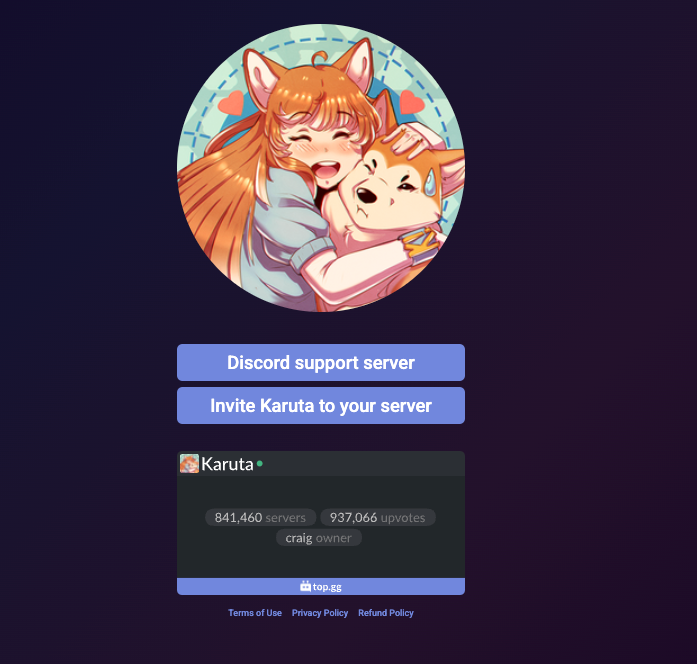Karuta: Lessons for B2C Startups & NFT Projects from a Discord Card Trading Bot

Karuta is a popular Discord bot that combines collecting, crafting, and trading into a compelling anime card game experience. At its core, it's a blend of these elements, all wrapped up in a Discord bot. It's a trading card game (TCG), primarily featuring anime characters, operating on a "gacha" system. This means you get cards periodically, with the frequency depending on your activity and the activity of the servers you're in. You can find a detailed description from the developer's mouth.
The core features of Karuta:
Unique Card Identity (NFTs):
Every single card in Karuta is unique, acting like a digital collectible or NFT. Think of it like a digital fingerprint – no two cards are exactly alike, even if they feature the same character. This concept closely resembles NFTs (Non-Fungible Tokens). This uniqueness isn't just a gimmick; it fundamentally changes how players interact with the cards and with each other. It creates a sense of ownership and rarity that goes beyond simply having a card of a particular character.
Crafting and Upgrading Your Cards:
Because each card is unique and belongs to you, players spend a lot of time making their cards better. This is where the "work" aspect comes in. As you play the Karuta Discord bot, you accumulate various in-game currencies. You can then use these currencies to improve your cards, making them visually newer, adding custom frames, changing their colors, and even transforming them into highly sought-after "mint" condition. This isn't just about aesthetics; upgraded cards often have higher trading value, both in terms of in-game currency and actual real money. The progression system provides a long-term goal for players, encouraging them to keep engaging with the game.
Trading Karuta Cards:
Trading is a massive part of the Karuta experience. Because cards are limited, especially the highly sought-after ones. Players trade different currencies, (there are about 5-10 various types of currencies), different cards, entire albums, and, importantly, there's even a real-money market for particularly rare or desirable cards. This vibrant trading ecosystem isn't just a simple exchange; it's a complex economy with its own internal logic and fluctuating values. Skilled traders can amass significant in-game wealth (and even real-world profit) by understanding these dynamics. In fact, most seasoned karuta players have their own spreadsheet keeping track of the real exchange rate value for different items.
Why Should You Care About Karuta's Success?
Here's a statistic that should grab your attention: Karuta boasts an estimated 300,000 to 800,000 daily active users. That's a level of engagement most B2C startups in Silicon Valley can only dream of. It typically takes a large team, millions in funding, and a dedicated marketing department to achieve this kind of reach.
Karuta, however, is likely run by a relatively small team, possibly even just a couple of indie developers. This highlights the incredible power of Discord as a platform for product adoption. And, crucially, this success has likely been achieved with minimal to no paid advertising. There's a lot we can all learn from Karuta's organic growth. This organic growth speaks volumes about the bot's inherent appeal and the effectiveness of word-of-mouth marketing within the Discord community. This makes Karuta a case study for any B2C startups looking to leverage community-driven growth.
Why is Karuta So Popular? Key Factors Driving Engagement
The Power of Familiar Anime IPs:
If you're an anime fan, you're almost guaranteed to recognize and connect with some of the characters featured on Karuta cards. This familiarity creates an innate desire to collect the characters you already love. This pre-existing connection is a massive advantage, instantly giving the cards a level of emotional resonance that a brand-new IP would struggle to achieve.
The Addictive Nature of Gacha Mechanics:
The core mechanic of receiving random card drops is inherently addictive. Cards can be dropped by anyone every 20 minutes, similar to Mudae, so in an active server with, say, 20 friends, you could potentially see new cards every minute, giving you constant opportunities to collect. The psychology behind this is well-documented: small actions with rewarding outcomes (getting a new card) create a powerful feedback loop, encouraging continued engagement. This is similar to how platforms like TikTok keep users hooked. The constant possibility of a rare or desirable drop keeps players engaged and checking back frequently.
Empowerment and Control Over Your Collection:
Unlike some other collection bots, Karuta gives players a significant degree of control over their collection. You're not just passively receiving cards; you're actively working to improve them. The various currencies, each with its own specific benefits, all revolve around customizing and enhancing the cards and anime characters you care about. This sense of agency and empowerment is a major draw for players who may not be primarily motivated by monetary gain. The ability to personalize and upgrade cards allows players to express their individuality and create something unique.
The Karuta "Black Market" (and Why It's Not the Main Driver):
Yes, there's a real-money market for Karuta cards. However, it's unlikely that most players are grinding and cultivating cards solely for the chance of making money. The core appeal lies elsewhere. While the profit potential might attract some users, the majority are likely driven by the collecting, crafting, and social aspects of the game.
The Thrill of Trading and the Karuta Economy:
With around 160,000 different cards and 500k+ players everyday, it's inevitable that you won't get the ones you want through drops. Trading provides a crucial avenue for players to acquire specific cards. By accumulating in-game currencies like gold, dust and tickets, you can participate in the vibrant trading communities and seek out the cards that complete your collection. This gives those currencies real utility within the game's ecosystem. The social interaction involved in trading, negotiating, and bartering adds another layer of engagement to the game. In fact, you can find a whole group of servers dedicated to nothing but karuta trading.
Showmanship, Validation, and the Karuta Community:
A quick look at online Karuta communities (like Reddit) reveals a strong culture of showing off. Players invest significant effort in upgrading their favorite cards and then proudly display the before-and-after transformations. While some cards are sold, many posts are simply about sharing achievements and receiving validation from other players. Karuta also provides ample room for creativity, allowing players to decorate their albums, create themed collections (like "waifus" or characters from Demon Slayer), and personalize their experience beyond just individual cards. This sense of community and shared accomplishment is a powerful motivator.
The Dev Team's Dedication (and the Controversy):
The Karuta development team actively works to prevent cheating, particularly the use of multiple alternate accounts ("alts") to unfairly collect cards and then trade them to a main account. They employ algorithms to detect and address this behavior. Truly valuable cards (remember, each card is unique) are often returned to an auction system to ensure they end up in the hands of legitimate players. This is a point of contention, as at a large scale, it's inevitable that some legitimate players might be incorrectly flagged. Balancing fairness and preventing exploitation is a constant challenge for the developers.
Would Karuta Be Popular Without Licensed IPs? A Hypothetical Scenario
This is a crucial question. The answer is likely yes, but it would be a much slower and more challenging climb. The fundamental desire to nurture something, to see it grow, and to create something unique is powerful and universal. However, the game's design would likely need significant adjustments.
Karuta has experimented with introducing non-IP-related characters, such as 3D idol characters. These characters can be upgraded and collected, but they haven't gained the same traction as the core anime-based cards. This could be due to Karuta's long history and established focus on anime, making it harder for new, non-IP content to break through. We will explore a similar bot named owo in a future post to provide a comparison.
Coming Up in Part 2: NFTs, Community Engagement, and Developer Lessons
This is just the beginning of our exploration of Karuta. In Part 2, we'll delve into even more fascinating aspects of this Discord phenomenon, including:
- What NFT Projects Can Learn from Karuta: The unique card system and thriving economy offer valuable lessons for the world of NFT, and also its dark side.
- Karuta's Impact on Community Engagement: Does Karuta foster a more engaged community, or does it create unhealthy competition? We'll examine the social dynamics.
- Key Takeaways for Bot and App Developers: What practical lessons can developers glean from Karuta's success, regardless of whether they're building games or other types of applications?
Stay tuned for a deeper dive into the world of Karuta!
